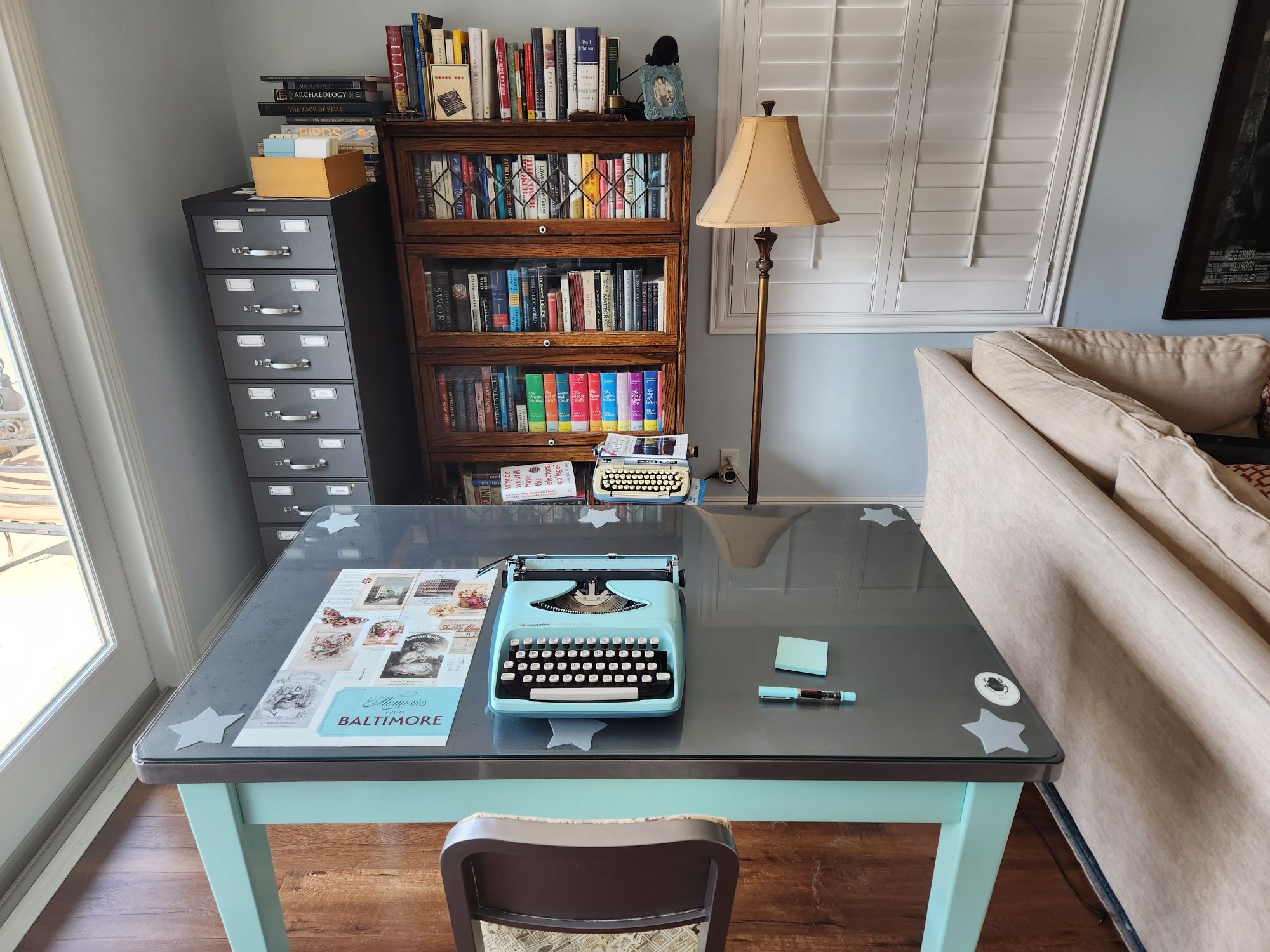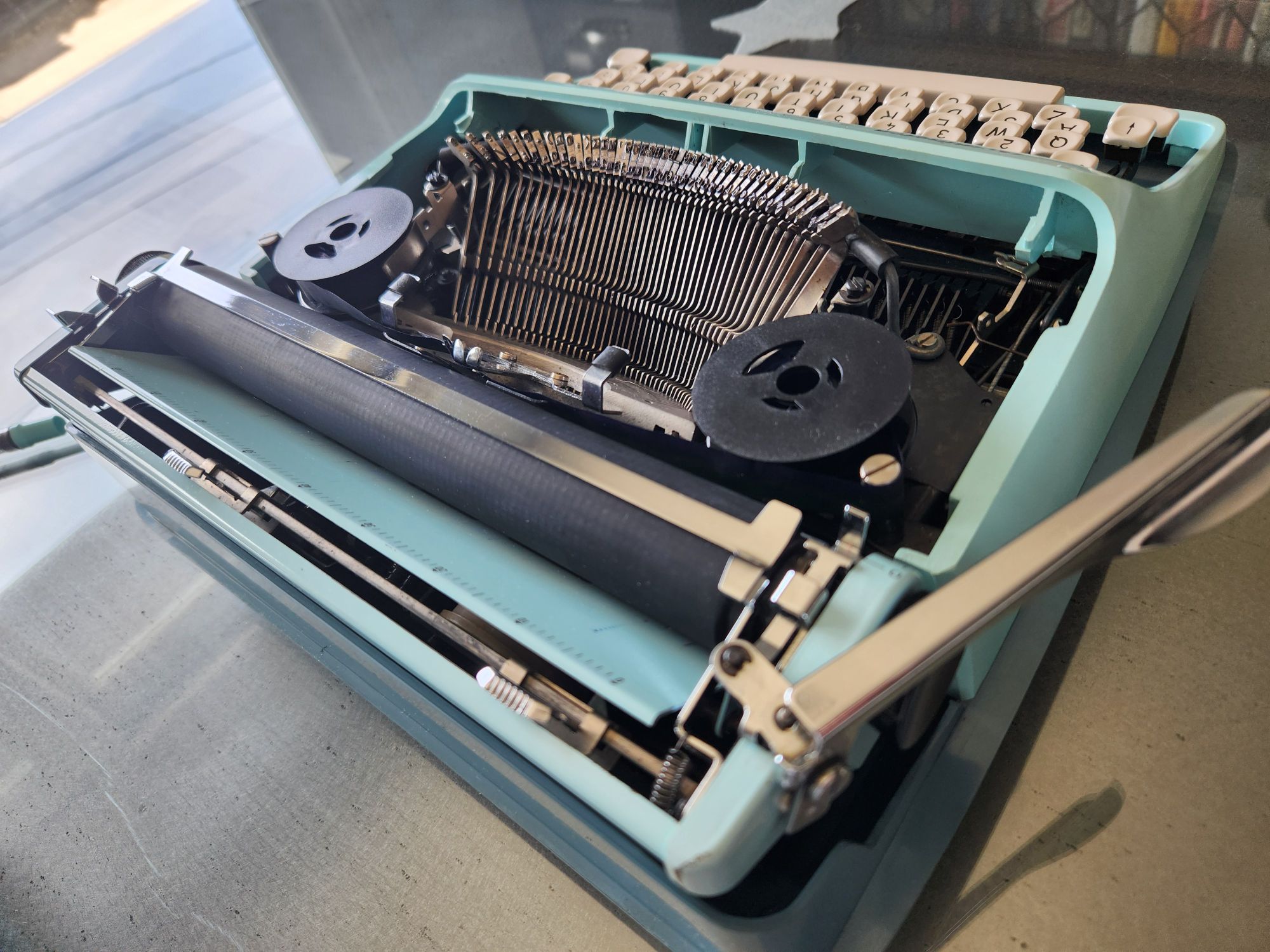On
March 11, 2023, I’d gotten a nice deal on a Remington Streamline portable typewriter in a generally uncontested online auction. I was certainly taking a small chance on a typewriter only by a few photos and the label “untested”, but I couldn’t resist the mint blue color which seemed like it would be a close match to my
TWSBI Eco T fountain pen and my
custom General Fireproofing 20 gauge steel desk.
Yesterday, the typewriter arrived, and today I took a short break to open it up and give it a short test drive. In addition to the fantastic news that the machine is in stunning shape, its color is about as perfect a match to the pen and the desk as one could ask!


Overall
The overall condition was beyond my dreams for this vintage and with some plastic portions. The typewriter only has a few signs of use and wear with some paint worn off at the corners of the back and on the right hand side where the platen knob meets the body. A bit of the “R” on the top Remington logo is worn off and seems to be thermally printed on, so I wouldn’t recommend heavy scrubbing, harsh abrasives, or caustic chemicals when cleaning the bodies of these for fear of removing the logo all together. These small flaws gives the machine some nice patina and the street cred of some reasonable use as a portable. There’s some small wear to the plastic hood where the two position return lever has rubbed against it. Otherwise it is in about as good a condition as one could hope.
All the keys worked with some severe stickiness on the “L” key. The smallest of tweaks on the head of the typebar remedied the issue without resorting to cleaning. The margin release wasn’t operating properly, but only because an obvious and easily re-mounted tension wire had become unhooked.
There is some minor grime and dust inside the body which could stand some cleaning, but it’s in great shape right out of the box. I’ll try to spend some time blowing it out and cleaning it up internally while I await some replacement ribbon.
The typewriter itself is has a metal chassis which is permanently screwed into a slightly darker plastic green base. This base dovetails with the plastic lid to create a case with a rubber-like plastic handle. Sadly the lid of the case was badly cracked and splintered into a dozen or so pieces in shipping, so I’m going to consider the lid a total loss. I’ll have to fashion some type of cover to keep the dust (and more importantly the German shepherd fur) out of the internal mechanisms.
On this model, the serial number is imprinted on to the black metal bottom chassis between the “U” and “J” keys when looking down at the typewriter from above. The serial number on my particular machine is AX 16 74 89. Sadly, the Typewriter Database doesn’t have serial numbers for this model or the late 60s or early 70s timespan in which these were made. One model in the database is dated to 1969 with a serial number starting with CX so it’s possible mine may be as early as ’68 or ’69 but sadly without better data, one can’t be sure.
Richard Polt has a Remington Streamliner manual for the 60s available, and though it’s close in broad look and functionality, it’s obviously not for this specific model or year.
Given the time period and the metallic mint paint, I do sort of wish this model also had Positraction, but then I suppose it would have needed to be produced by GM rather than Remington.

Keys
The keys appear to be thin beige pieces of almost bone-like plastic floating in mid-air but have thicker plastic and metal bases which give them a nice action. There’s a standard back space (curved arrow on the left), a margin release (double arrow on the right), but surprisingly for the age, is missing a dedicated 1/! key. There is no built-in tab functionality.

Ribbon
The machine has the typical larger Remington ribbon cores and this one included a dead, improperly seated ribbon on original metal rings. I swapped these out briefly for a new ribbon, though the plastic hub doesn’t seat as tightly as one would wish for the ribbon advance to work properly. I’ll get some new ribbon and handspool it onto the original cores and we should be off to the races. I’ll note that no metal ribbon covers, which had been standard on earlier models of this make, were present, though its probably just as likely that these were never included on their later models either for weight, functionality, or manufacturing cost reasons.
I’m don’t see any switch or button for the spool reverse, but suspect that the built-in mechanical sensors will operate as expected for Remingtons of this era. If not, it’s easy enough to actuate the switch manually with the hood off.
Also not available on this model is a switch for using two colored ribbons, so I’ll just have to be satisfied with a single color.

Other Functionality
As a later portable, the machine is missing some of the additional niceties of heavier late 50s or early 60s desk models. It does have a “card finger”, though only on the left. The return arm has two positions and a simple friction fit operation—one for use and the other for storage.
The machine has a carriage shift rather than a basket shift. The platen knobs are rather on the small side, and don’t have a typical button for variable line spacing. This line spacing functionality is built into the small switch on the left hand side for single or double spacing, but is labeled as “0” for small adjustments. It doesn’t appear to have a carriage lock of any sort, but does have margin stops and a satisfying bell.
In general, this model is a no-frills portable meant for basic functional typing on the go.
Typeface Sample
The pitch on this machine is 10 characters per inch (pica). The full platen is 85 characters wide.
Since I don’t have a properly inked/fitted ribbon for it yet, I’ll post a typeface sample at a later date.

Photo Gallery









































